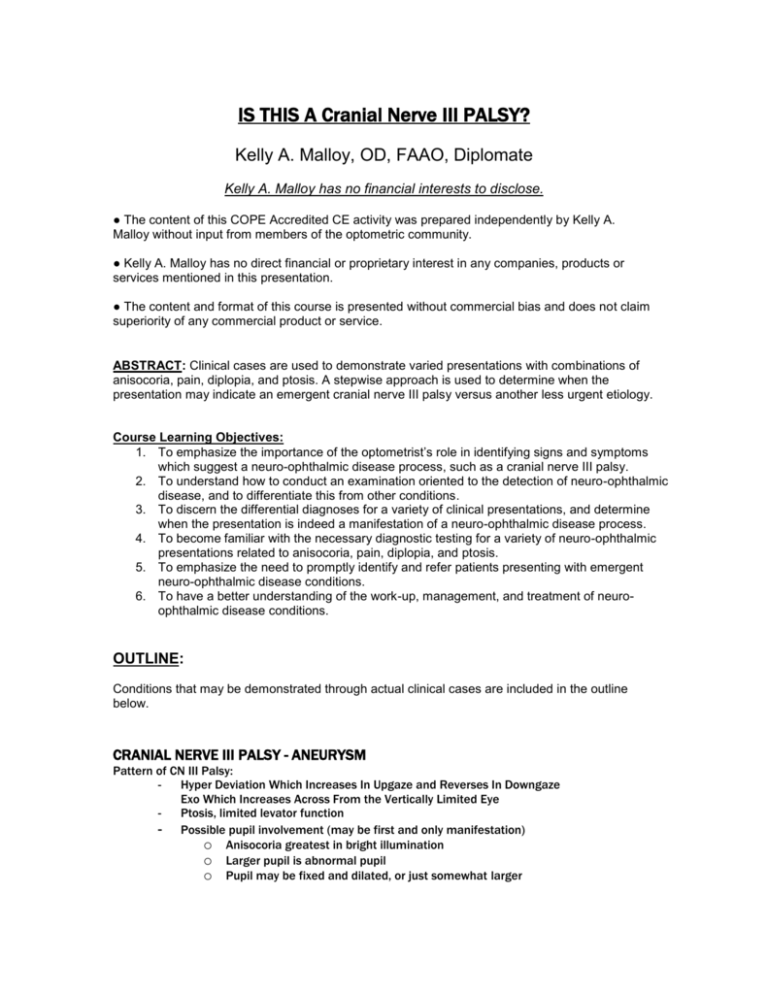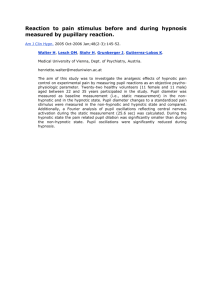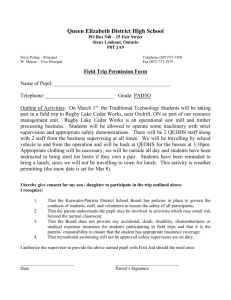NO-08 Outline
advertisement

IS THIS A Cranial Nerve III PALSY? Kelly A. Malloy, OD, FAAO, Diplomate Kelly A. Malloy has no financial interests to disclose. ● The content of this COPE Accredited CE activity was prepared independently by Kelly A. Malloy without input from members of the optometric community. ● Kelly A. Malloy has no direct financial or proprietary interest in any companies, products or services mentioned in this presentation. ● The content and format of this course is presented without commercial bias and does not claim superiority of any commercial product or service. ABSTRACT: Clinical cases are used to demonstrate varied presentations with combinations of anisocoria, pain, diplopia, and ptosis. A stepwise approach is used to determine when the presentation may indicate an emergent cranial nerve III palsy versus another less urgent etiology. Course Learning Objectives: 1. To emphasize the importance of the optometrist’s role in identifying signs and symptoms which suggest a neuro-ophthalmic disease process, such as a cranial nerve III palsy. 2. To understand how to conduct an examination oriented to the detection of neuro-ophthalmic disease, and to differentiate this from other conditions. 3. To discern the differential diagnoses for a variety of clinical presentations, and determine when the presentation is indeed a manifestation of a neuro-ophthalmic disease process. 4. To become familiar with the necessary diagnostic testing for a variety of neuro-ophthalmic presentations related to anisocoria, pain, diplopia, and ptosis. 5. To emphasize the need to promptly identify and refer patients presenting with emergent neuro-ophthalmic disease conditions. 6. To have a better understanding of the work-up, management, and treatment of neuroophthalmic disease conditions. OUTLINE: Conditions that may be demonstrated through actual clinical cases are included in the outline below. CRANIAL NERVE III PALSY - ANEURYSM Pattern of CN III Palsy: Hyper Deviation Which Increases In Upgaze and Reverses In Downgaze Exo Which Increases Across From the Vertically Limited Eye Ptosis, limited levator function - Possible pupil involvement (may be first and only manifestation) o Anisocoria greatest in bright illumination o Larger pupil is abnormal pupil o Pupil may be fixed and dilated, or just somewhat larger DEATH FROM SUBARACHNOID HEMORRHAGE 20% Of Patients With SAH Die Within 48 Hours ****need to consider aneurysm in all CN III palsy ANSWER BY PUPIL INVOLVED=ANEURYSM DOES NOT APPLY IF: Complicated CNIII Incomplete CNIII Relative Sparing 20-50 Years Of Age SPARED=VASCULOPATHIC ABERRANT REGENERATION OF CN III Pseudo Graefe Sign Eyelid Synkinesia Light-Near Dissociated Pupils ABERRANT REGENERATION OF CN III - CAUSES COMMON CAUSES: Aneurysm, Tumor, Trauma UNUSUAL: Inflammation NEVER: Diabetes Mellitus ISOLATED CN III PALSY IN ADULTS Undetermined Aneurysm Ischemia Trauma Neoplasm 24% 21% 18% 13% 12% CN III PALSY Work-up ADULTS 20-50 YEARS - CT, MRI, MRA, Arteriogram (R/O aneurysm immediately) 50+ YEARS (pupil, palsy, pain) – Neuroimaging, Vasculopathic Evaluation If Aneurysm is ruled out, other etiologies of CN III considered: Vasculopathic (should resolve in 3-6 months) Metastatic lesions to midbrain Carcinomatous meningitis Viral etiology TONIC PUPIL Damage to ciliary ganglion FEATURES OF TONIC PUPIL “FUNNY LOOKING PUPIL” MID-DILATED LIGHT NEAR DISASSOCIATION “3 S’s” Sector paralysis Stromal spread Stromal steaming • • • “Flat” edges “Vermiform” iris movement Poor response to light & near or LND • • “Dilation lag” following prolonged near effort “Paradoxical Pupil” - aniso greater in light & dim • Ciliary ganglion • 90% CB • 3% iris Aberrant regeneration of CB fibers to iris sphincter (light-near/gaze pupil dissociation) • Pharmacologic Testing for Adie’s Tonic Pupil • Weak (1/8 or 1/10) pilocarpine • Miosis owing to “denervation supersensitivity” • Acquired phenomenon Tonic Pupil Imposters • POSTERIOR SYNECHIA • ACUTE ANGLE CLOSURE • BITEMPORAL SPHINCTER PALSIES • TADPOLE SHAPED PUPILS Causes of Tonic Pupil • local (orbit) • infection • inflammation • ischemia • tumor • anesthesia (R-B block) • s/p surgery • toxicity (quinine) • s/p laser • trauma • neuropathic (diabetes) • s/p CN III palsy • Adie’s syndrome • • • Types of Tonic Pupil LOCAL • VARICELLA • RETROBULBAR • ORBITAL TUMOR • ORBITAL SURGERY • NEUROPATHIC • DIABETES • SYPHILIS • SARCOID • IDIOPATHIC (Adie’s) – unknown etiology Symptoms: • 20% ASYMPTOMATIC • 72% PUPIL RELATED • 35% CILIARY MUSCLE RELATED Accommodation effects • NORMAL • PARETIC • TONIC • INDUCED ASTIGMATISM @ NEAR • Features of Adie’s Tonic Pupil • FEMALE: MALE 2.6:1 • AGE: 20-40 • 90% UNILATERAL • FELLOW EYE @ 4% year • DIMINISHED CORNEAL SENSATION • DECREASED DEEP TENDON REFLEXES Management • PUPIL: LEAVE IT ALONE • ACCOMMODATION – (SUPERSENSTITIVITY CRAMP) – TONICITY = TROPINE – PARESIS = ESERINE – OCCLUSION ANGLE CLOSURE GLAUCOMA most common in people of Asian descent and people who are far-sighted The iris may be pushed forward up against the trabecular meshwork. The iris may be pulled up against the trabecular meshwork Resulting in increased intraocular pressure SYMPTOMS: Severe eye pain Nausea and vomiting Headache Blurred vision and/or seeing haloes around lights (Haloes and blurred vision occur because the cornea is swollen.) Profuse tearing Peripheral anterior synechiae (scarring) and adhesions may be visible between the cornea and the iris. Peripheral anterior synechiae may destroy the trabecular meshwork, and adhesions may cause permanent dilation of the iris. HORNER SYNDROME Anisocoria greater in dim illumination – damage to sympathetic pathway Smaller pupil is abnormal pupil Associated ptosis – muscle of Mueller – few mm ptosis at most MIOSIS, PTOSIS, ANHYDROSIS Anisocoria > Dim “Lazy Dilator” (Dilation Lag) Anisocoria > 5 Sec Than 12 Sec Measure in bright AND dim - Greater anisocoria in dim illumination Pancoast’s Tumor (Apical lung tumor) TRIAD: Ptosis, Miosis, Arm Pain CAROTID ARTERY DISSECTION CLASSIC TRIAD: Pain On Side Of Face, Head Or Neck, Oculosympathetic Paresis Without Anhydrosis, Delayed Retinal Or Cerebral Ischemia (50-95% Of Patients) SYMPTOMS Exploding, Ipsilat Headache Transient Monocular Blindness Diplopia Orbital, Facial, Neck, Jaw Pain Dysguesia Facial Numbness Neck Swelling SIGNS Horner’s Syndrome Neck Bruit Or Swelling CN VI, IX-XII CRAO Cerebral Ischemia Need to consider CAROTID DISSECTION in EVERY PAINFUL HORNER SYNDROME Can occur with or without trauma Medical Emergency Horner’ s with eye, head, neck pain - Pt to hospital (MRI, MRA, CTA, angiogram) MYASTHENIA GRAVIS NEUROMUSCULAR DISORDER WEAKNESS & FATIGABILITY OF VOLUNTARY MUSCLE DECREASE OF Ach RECEPTORS AUTOIMMUNE ATTACK PEAK INCIDENCE YOUNGER WOMEN (15-20) OLDER MEN (50-60) OVERALL F:M 2:1 UNDER 3O: F:M 4.5:1 23% HAVE AN ASSOCIATED IMMUNOLOGIC DISORDER 60% INITIAL PRESENTING SIGN IS AN OCULAR MANIFESTATION 90% WILL DEVELOP EYE SIGNS 15% WILL DEVELOP ONLY EYE SIGNS MG WORK-UP AChR ANTIBODY ASSAY (binding, blocking & modulating) MuSK Antibody TSH, T4, T3, thyroid antibodies (to r/o associated thyroid dysfunction) EMG (SINGLE FIBER) CHEST CT (to r/o thymoma in MG) PROGNOSIS IN 5 YEARS 40% STAY OCULAR 40% CONVERT TO GENERALIZED 11% SPONTANEOUS REMISSION 85% CONVERT TO GENERALIZED SYMPTOMATIC THERAPIES ACh ESTERASE INHIBITORS (MESTINON (pyridostigmine) / PROSTIGMIN (neostigmine)) IMMUNOTHERAPIES ANTICYTOKINE AGENTS CORTICOSTEROIDS, CYCLOSPORIN CYTOTOXIC: IMMURAN (azathioprine) HUMORAL THERAPY PLASMAPHERESIS, INTRAVENOUS GAMMA GLOBULIN SURGICAL THERAPY THYMECTOMY DRUGS TO AVOID IN MG IODINATED CONTRAST AGENTS CALCIUM CHANNEL BLOCKERS BETA-BLOCKERS: PROPRANOLOL, TIMOPTIC NEUROMUSCULAR BLOCKING AGENTS SUCCINLYCHOLINE, VECURONIUM QUININE, QUINIDINE, PROCAINAMIDE SELECTED ANTIBIOTICS AMINOGLYCOSIDES, CIPROFLOXACIN INTERNUCLEAR OPHTHALMOPLEGIA ADDUCTION DEFICIT WITH CONTRALATERAL ABDUCTING NYSTAGMUS An exo deviation that increases across from the MLF lesion, and therefore, across from the horizontally (medially) limited eye Localizes to the brainstem (Medial longitudinal fasciculus) Further localize by testing convergence Convergence spared = pons Convergence affected = midbrain FEATURES: UNILATERAL (INO) • VASCULAR • OLDER • MALES • APOPLECTIC • SKEW (43%) • UPGAZE NYSTAGMUS BILATERAL (BINO) • DEMYELINATING • YOUNGER • MALES = FEMALES • • • PROGRESSIVE SKEW (13%) UPGAZE NYSTAGMUS ADDITIONAL CAUSES: • HYDROCEPHALUS • TUBERCULOSIS MENINGITIS • PARANEOPLASTIC ENCEPHALOMYELITIS • HIV-CMV ENCEPHALITIS • HEAD TRAUMA • SLE • MIGRAINE • SUPRATENTORIAL AVM • INTRACRANIAL TUMOR





